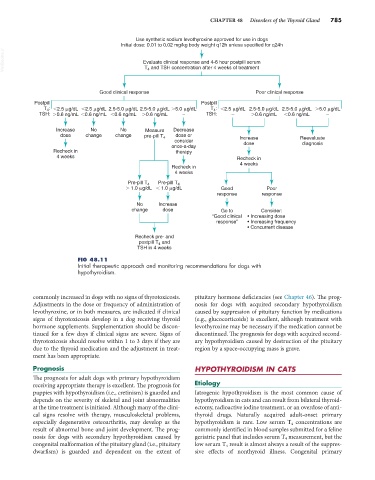Page 813 - Small Animal Internal Medicine, 6th Edition
P. 813
CHAPTER 48 Disorders of the Thyroid Gland 785
Use synthetic sodium levothyroxine approved for use in dogs
Initial dose: 0.01 to 0.02 mg/kg body weight q12h unless specified for q24h
VetBooks.ir Evaluate clinical response and 4-6 hour postpill serum
T 4 and TSH concentration after 4 weeks of treatment
Good clinical response Poor clinical response
Postpill Postpill
T : 2.5 g/dL 2.5 g/dL 2.5-5.0 g/dL 2.5-5.0 g/dL 5.0 g/dL T : 2.5 g/dL 2.5-5.0 g/dL 2.5-5.0 g/dL 5.0 g/dL
4
4
TSH: 0.6 ng/mL 0.6 ng/mL 0.6 ng/mL 0.6 ng/mL – TSH: – 0.6 ng/mL 0.6 ng/mL –
Increase No No Measure Decrease
dose change change pre-pill T 4 dose or Increase Reevaluate
consider dose diagnosis
once-a-day
Recheck in therapy
4 weeks Recheck in
4 weeks
Recheck in
4 weeks
Pre-pill T
Pre-pill T 4 4
1.0 g/dL 1.0 g/dL Good Poor
response response
No Increase
change dose Go to Consider:
“Good clinical • Increasing dose
response” • Increasing frequency
• Concurrent disease
Recheck pre- and
postpill T and
4
TSH in 4 weeks
FIG 48.11
Initial therapeutic approach and monitoring recommendations for dogs with
hypothyroidism.
commonly increased in dogs with no signs of thyrotoxicosis. pituitary hormone deficiencies (see Chapter 46). The prog-
Adjustments in the dose or frequency of administration of nosis for dogs with acquired secondary hypothyroidism
levothyroxine, or in both measures, are indicated if clinical caused by suppression of pituitary function by medications
signs of thyrotoxicosis develop in a dog receiving thyroid (e.g., glucocorticoids) is excellent, although treatment with
hormone supplements. Supplementation should be discon- levothyroxine may be necessary if the medication cannot be
tinued for a few days if clinical signs are severe. Signs of discontinued. The prognosis for dogs with acquired second-
thyrotoxicosis should resolve within 1 to 3 days if they are ary hypothyroidism caused by destruction of the pituitary
due to the thyroid medication and the adjustment in treat- region by a space-occupying mass is grave.
ment has been appropriate.
Prognosis HYPOTHYROIDISM IN CATS
The prognosis for adult dogs with primary hypothyroidism
receiving appropriate therapy is excellent. The prognosis for Etiology
puppies with hypothyroidism (i.e., cretinism) is guarded and Iatrogenic hypothyroidism is the most common cause of
depends on the severity of skeletal and joint abnormalities hypothyroidism in cats and can result from bilateral thyroid-
at the time treatment is initiated. Although many of the clini- ectomy, radioactive iodine treatment, or an overdose of anti-
cal signs resolve with therapy, musculoskeletal problems, thyroid drugs. Naturally acquired adult-onset primary
especially degenerative osteoarthritis, may develop as the hypothyroidism is rare. Low serum T 4 concentrations are
result of abnormal bone and joint development. The prog- commonly identified in blood samples submitted for a feline
nosis for dogs with secondary hypothyroidism caused by geriatric panel that includes serum T 4 measurement, but the
congenital malformation of the pituitary gland (i.e., pituitary low serum T 4 result is almost always a result of the suppres-
dwarfism) is guarded and dependent on the extent of sive effects of nonthyroid illness. Congenital primary

